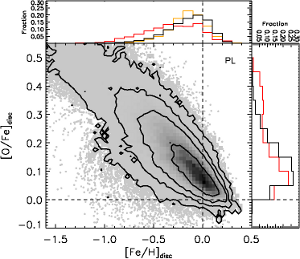|
|  |
Astronomical observations of chemical elements heavier than lithium
(known simply as "metals" in astrophysics) can tell us a lot about how
galaxies evolve. For example, the total amount of metal in the
interstellar gas of a galaxy correlates with the total number of stars
that were formed. Also, the ratio of oxygen to iron abundance in stars
(known as the oxygen enhancement, or simply [O/Fe]) is thought to act
as a galactic clock, telling us how quickly a galaxy grew. Galaxies
with high oxygen enhancement should have formed their stars rapidly,
before the iron from type Ia supernovae (SNe-Ia) could pollute the
star-forming gas. Galaxies with low oxygen enhancement, on the other
hand, should have formed their stars over an extended period of time,
with the youngest stars containing large amounts of SNe-Ia-produced
iron.
However, despite this standard and straight-forward theoretical
framework, sophisticated galaxy evolution models have been unable to
reproduce, at the same time, the complex chemical patterns seen in
different types of galaxy. Specifically, the metal abundances seen in
the photospheres of stars in the Milky Way and those seen in
integrated populations of old stars in elliptical galaxies could only
be reproduced simultaneously by invoking certain physical processes
that are not part of our canonical understanding of galaxy evolution.
Starting in 2010, a team of scientists from the MPA and University of
Sussex embarked on a project to reconcile the chemical properties seen
in these very different regions of the cosmos. Using their latest
semi-analytic model and a state-of-the-art implementation of the metal
enrichment of galaxies by stars, the team could reproduce the chemical
properties of the gas in nearby star-forming galaxies, of Sun-like
stars in the Milky Way, and of the old stars of elliptical
galaxies. Crucially, this is all done simultaneously and without any
radical departure from the standard framework of galaxy formation that
has seen so much success in other areas of astrophysics.
Our galaxy, the Milky Way contains around 300 billion stars with
various chemical properties, ranging from old, metal-poor stars to
young, metal-rich stars (see Figure 1). The team found that the
relation between iron abundance and oxygen enhancement for Sun-like
stars in a sample of model Milky-Way-type galaxies shows good
agreement with those observed in real Milky Way stars (see Figure
2). This tells us that the model is accurately representing the
chemical evolution of the Milky Way for the last thirteen billion
years.
The same model, with all the same assumptions about the physical
processes occurring in galaxies, also reproduces the chemical trends
seen in elliptical galaxies of different masses. In the real Universe,
the most massive ellipticals (see, for example, the galaxy in the
centre of Figure 3) are known to have a higher oxygen enhancement than
lower-mass ellipticals (see, for example, the galaxy in the top right
panel of Figure 3). In our model, we find the same correlation between
mass and oxygen enhancement.
And it's for the reason we would expect: high-mass ellipticals have
formed stars rapidly (before a lot of iron is produced), whereas
low-mass ellipticals formed their stars over a more extended period of
time (and so contain more iron). This result is a significant
achievement in itself, as it shows the relationship between the mass,
age and chemistry of ellipticals predicted by the model is similar to
that really observed, without requiring any major changes to the
standard galaxy formation paradigm.
So what is different about this new model that allows these results to
be achieved? The team believes that the key is the assumptions made
about the various metals ejected by different stars and the lifetimes
of SN-Ia progenitors. In their model, the simulated metal yields
depend on a star's mass and metallicity, and also take account of mass
loss via stellar winds prior to the final supernova explosion. In
addition, no more than half of the SNe-Ia progenitor systems should
explode within four hundred million years of their birth, and only
about one in a thousand of all the stars formed should produce a
SN-Ia. None of these conditions is particularly controversial, and
when combined with the detailed semi-analytic model the group obtained
the results described above.
But this is not the end of the story! The team are now working on
simultaneously reproducing the chemical properties of objects that are at
even more extreme ends of the galaxy spectrum. These tests will show
whether the same model can reproduce both the chemical evolution of
very-low-mass dwarf galaxies and the iron content of the hot gas
surrounding the most massive galaxy clusters. Such tests are also
crucial to validating any galaxy formation model, and should teach us
even more about the true nature of galaxies in the nearby Universe.
Rob Yates and Guinevere Kauffmann
References:
Yates R. M., Henriques B., Thomas P. A., Kauffmann G., Johansson J., White S. D. M.,
2013, MNRAS, accepted
 http://arxiv.org/pdf/1305.7231v1.pdf http://arxiv.org/pdf/1305.7231v1.pdf
|




